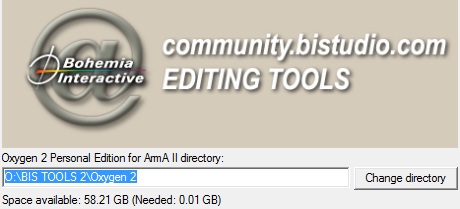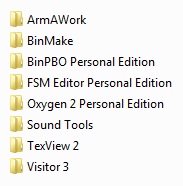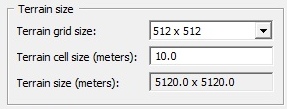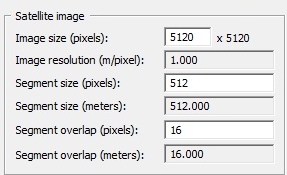Terrain Tutorial – Arma 2
Introduction
This simple learning by doing tutorial will explain the basic process of creating an island for ArmA 2, Operation Arrowhead or Combined Operations.
What the tutorial will deal with:
- Setup Editing Tools 2
- Preparing the Working folder
- Setup Visitor & The Landscape
- Binarizing your world properly.
- Adding Objects
- Add more Surfaces
Installation of the BI Editing Tools 2
It is very important to choose a proper place to install the BI Editing Tools 2 before starting with anything else. A clean, empty partition is highly recommended (see how to create a partition).
In this tutorial we will use the partition: O:\.
- 1: Download the BI Editing Tools 2 first.
- 2: Next create a folder called BIS TOOLS 2 in your designated partition. In our example: O:\BIS TOOLS 2\.
- 3: Open or extract the downloaded zip file and start the BI_Editing_Tools_2_Setup.exe.
- 4: The installer is basically self explanatory. Make sure to change the directory for each tool from the default location to your desired folder. In our example: O:\BIS TOOLS 2\.
Make sure to define the respective path for each tool. E.g.: O:\BIS TOOLS 2\Oxygen 2 O:\BIS TOOLS 2\Visitor 3 .. and so on.
- 5: All tools should be installed now in respective directory (O:\BIS TOOLS 2\). Every Tool is stored in its own folder:
Video Tutorial
You can watch the installation process in this Video Tutorial : Setup Editing Tools 2.
The mysterious P: drive
A new partition called P: will be automatically created during the setup. An ArmAWork folder will be created in your my documents folder as well.
..\my documents\ArmAWork
Understand that the P: drive the ArmAWork folder are the same. They are just different views on the same folder.
You can read more about the tools drive here.
Note that the name tools drive is very misleading. It is your editing workspace (virtual) drive.
The P: drive has two main tasks:
- Your personal workspace. So the place where you files will reside.
- Extracted source files from BI or other sources you want to use in your terrain.
More details below.
Note that P: Drive already contains the ca folder. ca is the project space from BI.
Never ever put your files into p:\ca\*.
In this folder we will extract the source of the BI files currently still in the PBO as part of the game folder. Right now the ca folder contains a couple of unpacked pbo files already and another folder called Roads2.
We will ignore these for now.
Configure the tools
- 1: Go to P:\CA\ and create a new folder called plants2.
- 2: Browse to your ArmA2 main directory/Addons folder and unpack the plants2_bush, plants2_clutter, plants2_misc, plants2_tree .pbo's
- How to Extract Pbo files?
- Download the latest Versions of ExtractPbo and DePbo by Mikero at DevHeaven
- Extract them right into our Tutorial partition O:\ComTools\ExtractPbo.....(xp home users extract tools to a manual folder called Com Tools in the P partition.)
- Move the DePbo.dll from the downloaded DePbo into the ..Windows\System32 folder (as explained in the readme.DePbo.txt)
- Rightclick on a *.pbo and choose Open with, then point to the ExtractPbo\ExtractPbo.exe and mark the checkbox to always open this filetype with ExtractPbo.exe.
- Now each time you unpack a *.pbo by doubleclick you'll receive a clean unpacked file with *.p3ds, config.cpp and all other stuff from the pbo.
- There are of course much further ways to extract pbos and unrap config.bin's but this is a very conformable one.
- 3: Rename this extracted folders by removing "plants2_" of the name.
- 4: Cut&Paste the bush, clutter, misc and tree folders to the new created P:\CA\plants2\ folder.
- 5: Do the same with the building2.pbo. This time you don't need to rename anything.
- 6: Now extract the Ca.pbo but only Cut&Paste the stuff inside the extracted Ca.pbo to P:\CA\
- You can do this with all other pbos but for this tutorial we are only using building2&plants2.
- 7: When it´s done so your P:\CA\ should look as shown in the picture below. (XP home users convert all Chernarus content have folder/subfolders same name , .cpp file down in tut.)
Your Project folder
The project is your workspace - the place you can go crazy inside and have all your files in.
First register your personal tag at OFPEC. Read more about tags at OFPEC. In short a tag is to avoid name conflicts.
This tutorial will use as the tag TUT. Make sure to use your own tag registered at OFPEC.
With our new shiny tag, we create a namespace in the P:\ drive. In other words a subfolder. So go create it now.
For this tutorial it is: P:\TUT\.
Let us make the meaning of the project folder clear - The project folder is for all your various future projects. So for the individual projects we will soon create subfolders inside our project folder.
Working animations/ladders
Up next is the important part to make sure that we have working animations/ladders on our world. For that we need the respective config files from each object which we are about to use within our world.
TODO
- 3: To do that we can easy create a small bat or use the windows command line: Navigate to the P:\ca folder and
- 4: Run the following dos command: xcopy *.cpp P:\<YourNamespace>\ca\ /S /Y Or manually move the cpps with the correct folder structure to your namespace
- If your not familiar with cmd then put this copy_cpp.bat in your P:\CA\ folder and run it.(XP-- P partition run,.cpp file to ca)
- This command creates a duplicate set of '\ca' folders under your namespace and copies only the config.cpp files to each subfolder.
Setup Visitor
This Part of the Tutorial will work for xp home users (SAVE your WORK), Vista is a work in progress.
- 1: Download the Tutorial Sample Map and extract it to our P:\TUT\ folder so it will look like P:\TUT\TUT_SampleMap
- 2: Run the O:\BI TOOLS 2\Visitor 3\Visitor3.exe
- 3: Open Tools -> SystemPreferences and check if all paths are correct
Hint: If you are using arma2.exe from your present game version then you need to replace the bin folder in p:/ with the extracted bin.pbo from your present game version too, otherwise there is a mismatch of shaders.
Start with our Project
- 1: Open Project -> New (or press Ctrl+N)
- 2: In the next Project parameters window select the values for:
- Terrain grid size 512x512
- Terrain cell size 10
- detailed information about the Project Parameters can be read in the Visitor 3 Manual
- 3: Go to Tools -> Project parameters and open the Calculator and put in Image Size (Pixels): 5120. Hit apply and close only the Calculator
- 4: Open Tools -> ProjectPreferences and enter the path to your data folder (Textures): P:\TUT\TUT_SampleMap\Data\. Click ok and close.
- 5: In the Project parameters window click on Base (active) and press the Edit Button. Choose 40x40m Texture size. Apply and close the Project parameters window SAVE

Import Terrain
- 1: Go to Open -> Import Terrain from Picture and browse to P:\TUT\TUT_SampleMap\Source\terrain\terrain.pbl
- Be sure you set the view to elevation colour style (hit the 5th button from the left) to see the contours.
Save after each step
- Goto Poject -> SaveAs and save your map as TUT_SampleMap.pew (add .pew to your filename, otherwise vis will not recognise the file)
Import Satellite & Mask
- 1: Go to Tools -> Import Satellite + Mask.. and browse to P:\TUT\TUT_SampleMap\Source\layer.cfg
- 2: Select text mode for saving the rvmats in the next window .
- 3: Visitor asks now for the Sat file so browse to P:\TUT\TUT_SampleMap\Source\sat_lco.png
- 4: Same with the Mask point it to P:\TUT\TUT_SampleMap\Source\mask_lco.png
- 5: The import process begins right after you hit OK. That may take some minutes and Visitor might not respond until process has finally finished.
- 6: Point the mouse somewhere in the middle of the map and hit the centre mousebutton (wheel). A white square appears right at this position (point of view).
- 7: Start Buldozer via Project -> Connect to Buldozer (or hit the ! icon)
- 8: Buldozer converts the Textures automatically from png to paa (DOS window)
- 9: After the conversion process has finished you should be able to see the landscape in buldozer. The textures will appear so more you zoom onto the surface.
- 10: Switch back to Visitor by hit Alt+Tab (don't close buldozer) and go to Project -> Export World and save it under P:\TUT\TUT_SampleMap\TUT_SampleMap.wrp
Binarizing your world
- 1: Start BinPbo O:\BIS TOOLS 2\BinPBO Personal Edition\BinPBO.exe.
- 2: Choose the P:\TUT\TUT_SampleMap in the addon/source directory field.
- 3: Now go to your ArmA2 Main folder and create a new folder called @TUT. Open this one and create another one which is called Addons (F:\Games\ArmA 2\@TUT\Addons).
- 4: Back in BinPbo we set F:\Games\ArmA 2\@TUT\Addons as destination directory.
- 5: Open the BinPbo options and remove *.wrp out of the list of files to copy directly
- 6: In the path of temporary folder we set P:\BIN_TEMP
- 7: Now remove the hook from use source path and enter p:\tut\
- 8: We are ready to binarize our Island. Close the options tab and click on Pack. That may take a while, wait until Ready appears at the bottom of BinPBO.
- 9: After BinPbo has finished you should see in your F:\Games\ArmA 2\@TUT\Addons\ folder the tut_samplemap.pbo and the logfile.
- 10: Add the @TUT Mod folder to your ArmA2.exe shortcut ("F:\Games\ArmA 2\arma2.exe" -mod=@TUT -window -nosplash) or use one of the meanwhile available ArmA2 launchers.
- Check out your map Ingame :-)
Objects and Various Tips
Terrain editing
U will raise the height of a vertex slightly I will raise the height of the vertex greatly J will lower the height of a vertex slightly K will lower the height of a vertex greatly
About vertices
You may have to hit F or G (i forget which) to show the arrow that goes to each centre point of a vertex. While moving the mouse around the map, you'll notice that the arrow cursor 'sticks' to the closest centre point of a vertex.
Think of a vertex as a hexagonal shape where you simply raise or lower the centre point of that shape. So, when you raise a vertex, it'll make a point upwards. Doing it repeatedly will make the point higher and 'sharper'. Therefore to make sure your terrain isn't too sharp, you'll have to raise the vertices around it as well.
Keep in mind also that editing vertices is pretty tedious, and it should really only be used for tweaking height.
Road networks do not act as objects, therefore you can only select, move, or budge them in Visitor 3. (thx to El Mariachi)







